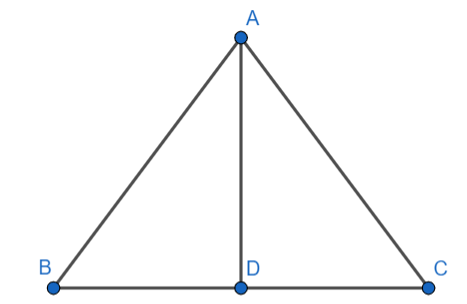
In a triangle ABC, AD is perpendicular to BC. Prove that $A{{B}^{2}}-A{{C}^{2}}=B{{D}^{2}}-C{{D}^{2}}$.


Answer
599.1k+ views
Hint: In a right-angled triangle ABC right-angled at B $A{{C}^{2}}=A{{B}^{2}}+B{{C}^{2}}$. This is known as Pythagoras theorem. Use Pythagora's theorem in triangles ABD and ACD and equate $A{{D}^{2}}$. Simplify to get the above result.
Complete step by step answer: -
Given: A triangle ABC. $\text{AD}\bot \text{BC}$.
To prove : $A{{B}^{2}}-A{{C}^{2}}=B{{D}^{2}}-C{{D}^{2}}$
Proof:
Using Pythagoras theorem in triangle ABD, we get
$\text{A}{{\text{B}}^{2}}=\text{A}{{\text{D}}^{2}}+\text{B}{{\text{D}}^{2}}$
Subtracting $\text{B}{{\text{D}}^{2}}$ from both sides we get
$\begin{align}
& \text{A}{{\text{B}}^{2}}-\text{B}{{\text{D}}^{2}}=\text{A}{{\text{D}}^{2}}+\text{B}{{\text{D}}^{2}}-\text{B}{{\text{D}}^{2}} \\
& \Rightarrow \text{A}{{\text{B}}^{2}}-\text{B}{{\text{D}}^{2}}=\text{A}{{\text{D}}^{2}}\text{ (i)} \\
\end{align}$
Similarly, using Pythagoras theorem in triangle ACD, we get
$\text{A}{{\text{C}}^{2}}=\text{A}{{\text{D}}^{2}}+\text{C}{{\text{D}}^{2}}$
Subtracting $\text{C}{{\text{D}}^{2}}$ from both sides, we get
$\begin{align}
& \text{A}{{\text{C}}^{2}}-\text{C}{{\text{D}}^{2}}=\text{A}{{\text{D}}^{2}}+\text{C}{{\text{D}}^{2}}-\text{C}{{\text{D}}^{2}} \\
& \Rightarrow \text{A}{{\text{C}}^{2}}-\text{C}{{\text{D}}^{2}}=\text{A}{{\text{D}}^{2}}\text{ (ii)} \\
\end{align}$
From equation (i) and equation (ii), we get
$\text{A}{{\text{B}}^{2}}-\text{B}{{\text{D}}^{2}}=\text{A}{{\text{C}}^{2}}-\text{C}{{\text{D}}^{2}}$
Adding $\text{B}{{\text{D}}^{2}}-\text{A}{{\text{C}}^{2}}$ on both sides, we get
$\begin{align}
& \text{A}{{\text{B}}^{2}}-\text{B}{{\text{D}}^{2}}+\text{B}{{\text{D}}^{2}}-\text{A}{{\text{C}}^{2}}=\text{A}{{\text{C}}^{2}}-\text{C}{{\text{D}}^{2}}+\text{B}{{\text{D}}^{2}}-\text{A}{{\text{C}}^{2}} \\
& \Rightarrow \text{A}{{\text{B}}^{2}}-\text{A}{{\text{C}}^{2}}=\text{B}{{\text{D}}^{2}}-\text{C}{{\text{D}}^{2}} \\
\end{align}$
Hence proved.
Note: Alternatively, we can use trigonometry to prove the above statement
There are six trigonometric ratios defined on an angle of a right-angled triangle, viz sine, cosine,
tangent, cotangent, secant and cosecant.
The sine of an angle is defined as the ratio of the opposite side to the hypotenuse.
The cosine of an angle is defined as the ratio of the adjacent side to the hypotenuse.
The tangent of an angle is defined as the ratio of the opposite side to the adjacent side.
The cotangent of an angle is defined as the ratio of the adjacent side to the opposite side.
The secant of an angle is defined as the ratio of the hypotenuse to the adjacent side.
The cosecant of an angle is defined as the ratio of the hypotenuse to the adjacent side.
If $\text{A}{{\text{B}}^{2}}-\text{A}{{\text{C}}^{2}}=\text{B}{{\text{D}}^{2}}-\text{C}{{\text{D}}^{2}}$ then on dividing both sides by $\text{A}{{\text{D}}^{2}}$ we get
$\dfrac{\text{A}{{\text{B}}^{2}}-\text{A}{{\text{C}}^{2}}}{\text{A}{{\text{D}}^{2}}}=\dfrac{\text{B}{{\text{D}}^{2}}-\text{C}{{\text{D}}^{2}}}{\text{A}{{\text{D}}^{2}}}$
We know that $\dfrac{a-b}{c}=\dfrac{a}{c}-\dfrac{b}{c}$.
Using the above identity, we get
${{\left( \dfrac{\text{AB}}{\text{AD}} \right)}^{2}}-{{\left( \dfrac{\text{AC}}{\text{AD}} \right)}^{2}}={{\left( \dfrac{\text{BD}}{\text{AD}} \right)}^{2}}-{{\left( \dfrac{\text{CD}}{\text{AD}} \right)}^{2}}$
In triangle ABD we have
$\csc \text{B=}\dfrac{\text{AB}}{\text{AD}}$ and $\cot \text{B=}\dfrac{\text{BD}}{\text{AD}}$
In triangle ACD we have
$\csc \text{C=}\dfrac{\text{AC}}{\text{AD}}$ and $\cot \text{C=}\dfrac{\text{CD}}{\text{AD}}$
Substituting these values, we get
${{\csc }^{2}}\text{B-}{{\csc }^{2}}\text{C=}{{\cot }^{2}}\text{B-}{{\cot }^{2}}\text{C}$
Adding ${{\csc }^{2}}\text{C-co}{{\text{t}}^{2}}\text{B}$ on both sides, we get
$\begin{align}
& {{\csc }^{2}}\text{B-}{{\csc }^{2}}\text{C+}{{\csc }^{2}}\text{C-co}{{\text{t}}^{2}}\text{B=}{{\cot }^{2}}\text{B-}{{\cot }^{2}}\text{C+}{{\csc }^{2}}\text{C-co}{{\text{t}}^{2}}\text{B} \\
& {{\csc }^{2}}\text{B}-{{\cot }^{2}}\text{B=}{{\csc }^{2}}\text{C-}{{\cot }^{2}}\text{C} \\
\end{align}$
We know that ${{\csc }^{2}}x-{{\cot }^{2}}x=1$
Using we have $1=1$
Which is true.
Hence $\text{A}{{\text{B}}^{2}}-\text{A}{{\text{C}}^{2}}=\text{B}{{\text{D}}^{2}}-\text{C}{{\text{D}}^{2}}$
Hence proved.
Complete step by step answer: -
Given: A triangle ABC. $\text{AD}\bot \text{BC}$.
To prove : $A{{B}^{2}}-A{{C}^{2}}=B{{D}^{2}}-C{{D}^{2}}$
Proof:
Using Pythagoras theorem in triangle ABD, we get
$\text{A}{{\text{B}}^{2}}=\text{A}{{\text{D}}^{2}}+\text{B}{{\text{D}}^{2}}$
Subtracting $\text{B}{{\text{D}}^{2}}$ from both sides we get
$\begin{align}
& \text{A}{{\text{B}}^{2}}-\text{B}{{\text{D}}^{2}}=\text{A}{{\text{D}}^{2}}+\text{B}{{\text{D}}^{2}}-\text{B}{{\text{D}}^{2}} \\
& \Rightarrow \text{A}{{\text{B}}^{2}}-\text{B}{{\text{D}}^{2}}=\text{A}{{\text{D}}^{2}}\text{ (i)} \\
\end{align}$
Similarly, using Pythagoras theorem in triangle ACD, we get
$\text{A}{{\text{C}}^{2}}=\text{A}{{\text{D}}^{2}}+\text{C}{{\text{D}}^{2}}$
Subtracting $\text{C}{{\text{D}}^{2}}$ from both sides, we get
$\begin{align}
& \text{A}{{\text{C}}^{2}}-\text{C}{{\text{D}}^{2}}=\text{A}{{\text{D}}^{2}}+\text{C}{{\text{D}}^{2}}-\text{C}{{\text{D}}^{2}} \\
& \Rightarrow \text{A}{{\text{C}}^{2}}-\text{C}{{\text{D}}^{2}}=\text{A}{{\text{D}}^{2}}\text{ (ii)} \\
\end{align}$
From equation (i) and equation (ii), we get
$\text{A}{{\text{B}}^{2}}-\text{B}{{\text{D}}^{2}}=\text{A}{{\text{C}}^{2}}-\text{C}{{\text{D}}^{2}}$
Adding $\text{B}{{\text{D}}^{2}}-\text{A}{{\text{C}}^{2}}$ on both sides, we get
$\begin{align}
& \text{A}{{\text{B}}^{2}}-\text{B}{{\text{D}}^{2}}+\text{B}{{\text{D}}^{2}}-\text{A}{{\text{C}}^{2}}=\text{A}{{\text{C}}^{2}}-\text{C}{{\text{D}}^{2}}+\text{B}{{\text{D}}^{2}}-\text{A}{{\text{C}}^{2}} \\
& \Rightarrow \text{A}{{\text{B}}^{2}}-\text{A}{{\text{C}}^{2}}=\text{B}{{\text{D}}^{2}}-\text{C}{{\text{D}}^{2}} \\
\end{align}$
Hence proved.
Note: Alternatively, we can use trigonometry to prove the above statement
There are six trigonometric ratios defined on an angle of a right-angled triangle, viz sine, cosine,
tangent, cotangent, secant and cosecant.
The sine of an angle is defined as the ratio of the opposite side to the hypotenuse.
The cosine of an angle is defined as the ratio of the adjacent side to the hypotenuse.
The tangent of an angle is defined as the ratio of the opposite side to the adjacent side.
The cotangent of an angle is defined as the ratio of the adjacent side to the opposite side.
The secant of an angle is defined as the ratio of the hypotenuse to the adjacent side.
The cosecant of an angle is defined as the ratio of the hypotenuse to the adjacent side.
If $\text{A}{{\text{B}}^{2}}-\text{A}{{\text{C}}^{2}}=\text{B}{{\text{D}}^{2}}-\text{C}{{\text{D}}^{2}}$ then on dividing both sides by $\text{A}{{\text{D}}^{2}}$ we get
$\dfrac{\text{A}{{\text{B}}^{2}}-\text{A}{{\text{C}}^{2}}}{\text{A}{{\text{D}}^{2}}}=\dfrac{\text{B}{{\text{D}}^{2}}-\text{C}{{\text{D}}^{2}}}{\text{A}{{\text{D}}^{2}}}$
We know that $\dfrac{a-b}{c}=\dfrac{a}{c}-\dfrac{b}{c}$.
Using the above identity, we get
${{\left( \dfrac{\text{AB}}{\text{AD}} \right)}^{2}}-{{\left( \dfrac{\text{AC}}{\text{AD}} \right)}^{2}}={{\left( \dfrac{\text{BD}}{\text{AD}} \right)}^{2}}-{{\left( \dfrac{\text{CD}}{\text{AD}} \right)}^{2}}$
In triangle ABD we have
$\csc \text{B=}\dfrac{\text{AB}}{\text{AD}}$ and $\cot \text{B=}\dfrac{\text{BD}}{\text{AD}}$
In triangle ACD we have
$\csc \text{C=}\dfrac{\text{AC}}{\text{AD}}$ and $\cot \text{C=}\dfrac{\text{CD}}{\text{AD}}$
Substituting these values, we get
${{\csc }^{2}}\text{B-}{{\csc }^{2}}\text{C=}{{\cot }^{2}}\text{B-}{{\cot }^{2}}\text{C}$
Adding ${{\csc }^{2}}\text{C-co}{{\text{t}}^{2}}\text{B}$ on both sides, we get
$\begin{align}
& {{\csc }^{2}}\text{B-}{{\csc }^{2}}\text{C+}{{\csc }^{2}}\text{C-co}{{\text{t}}^{2}}\text{B=}{{\cot }^{2}}\text{B-}{{\cot }^{2}}\text{C+}{{\csc }^{2}}\text{C-co}{{\text{t}}^{2}}\text{B} \\
& {{\csc }^{2}}\text{B}-{{\cot }^{2}}\text{B=}{{\csc }^{2}}\text{C-}{{\cot }^{2}}\text{C} \\
\end{align}$
We know that ${{\csc }^{2}}x-{{\cot }^{2}}x=1$
Using we have $1=1$
Which is true.
Hence $\text{A}{{\text{B}}^{2}}-\text{A}{{\text{C}}^{2}}=\text{B}{{\text{D}}^{2}}-\text{C}{{\text{D}}^{2}}$
Hence proved.
Recently Updated Pages
Two men on either side of the cliff 90m height observe class 10 maths CBSE

What happens to glucose which enters nephron along class 10 biology CBSE

Cutting of the Chinese melon means A The business and class 10 social science CBSE

Write a dialogue with at least ten utterances between class 10 english CBSE

Show an aquatic food chain using the following organisms class 10 biology CBSE

A circle is inscribed in an equilateral triangle and class 10 maths CBSE

Trending doubts
Which of the following does not have a fundamental class 10 physics CBSE

What is the full form of POSCO class 10 social science CBSE

State BPT theorem and prove it class 10 maths CBSE

A Gulab jamun contains sugar syrup up to about 30 of class 10 maths CBSE

Write the difference between soap and detergent class 10 chemistry CBSE

A triangle ABC is drawn to circumscribe a circle of class 10 maths CBSE




